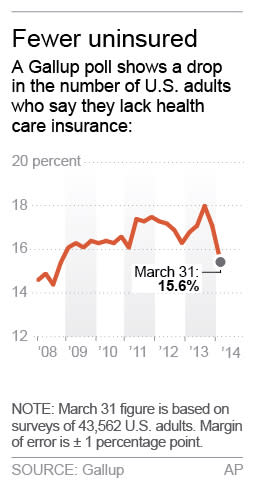Survey confirms gains in health insurance sign-ups
WASHINGTON (AP) — A growing share of Americans got health insurance as sign-up season for President Barack Obama's health care law came to a close last month, a major survey released Monday has found.
The Gallup-Healthways Well-Being Index provides independent validation for White House claims that the law is expanding access, particularly for working people with no coverage on the job. But the improvement, while substantial, doesn't appear as large as some of the numbers claimed by the law's supporters.
Gallup found that the share of adults without health insurance shrank from 17.1 percent at the end of last year to 15.6 percent for the first three months of 2014.
The decline of 1.5 percentage points would translate roughly to more than 3.5 million people gaining coverage. The trend accelerated as the March 31 enrollment deadline loomed.
"The Affordable Care Act, commonly referred to as 'Obamacare,' appears to be accomplishing its goal of increasing the percentage of Americans with health insurance," said Gallup's analysis of the findings.
The survey is important because it combines the quick turnaround of media polls with extensive outreach usually seen in government research. Gallup interviewed more than 43,500 adults, or more than 40 times the number in a typical national media poll.
Coming a week after the close of the health care law's first enrollment season, Gallup's numbers suggest a more modest impact on coverage than statistics cited by the Obama administration.
The administration says more than 7 million have signed up for subsidized private plans through new insurance markets. Additionally, 3 million previously uninsured people gained coverage through the law's Medicaid expansion.
Millions more remain potentially eligible for marketplace coverage under various extensions issued by the administration. White House senior adviser Dan Pfeiffer said this weekend on CBS that 200,000 people who had started applications but weren't able to finish by the deadline got signed up later in the week.
However, the administration's numbers are not comparable with Gallup's.
The White House figure of 7 million-plus insurance exchange sign-ups includes insured people who switched their previous coverage, as well as people who have not paid their first month's premium, and who would therefore still be uninsured.
Also, Gallup is counting just adults, while the administration figures include children as well.
It may take much of the rest of the year to get a true bottom line of the health care law's impact on coverage.
Still, Gallup's numbers do show an improving trend. The share of Americans without coverage is at its lowest since late 2008, before Obama took office, the survey found.
"This survey and other independent analyses highlight a historic expansion in coverage," said Aaron Albright, a spokesman for the Health and Human Services department.
The survey also speaks to concerns about the consequences from last fall's wave of insurance cancellations. Gallup's data suggest most of the people whose existing policies did not measure up under the law were able to get new coverage, or took advantage of exceptions belatedly issued by the White House.
Gallup found the biggest insurance gains were among lower-income people and among African-Americans.
Among people with household incomes of less than $36,000 a year, the share of uninsured shrank by 3.2 percentage points from levels at the end of 2013.
African-Americans saw their uninsured rate drop by 3.3 percentage points.
Although the proportion of Hispanics without coverage fell by 1.7 percentage points, Latinos remained more likely than any racial or ethnic group to lack access, with 37 percent uninsured.
Gallup found gains in coverage among all age groups, but not much evidence of a late surge of younger people that the administration had hoped for to help keep premiums in check.
Results were based on telephone interviews conducted Jan. 2 -March 31 with a random sample of 43,562 adults 18 and older living in all 50 states and Washington, D.C. For results based on the total sample of national adults, the margin of sampling error is plus or minus 1 percentage point at the 95 percent confidence level.



